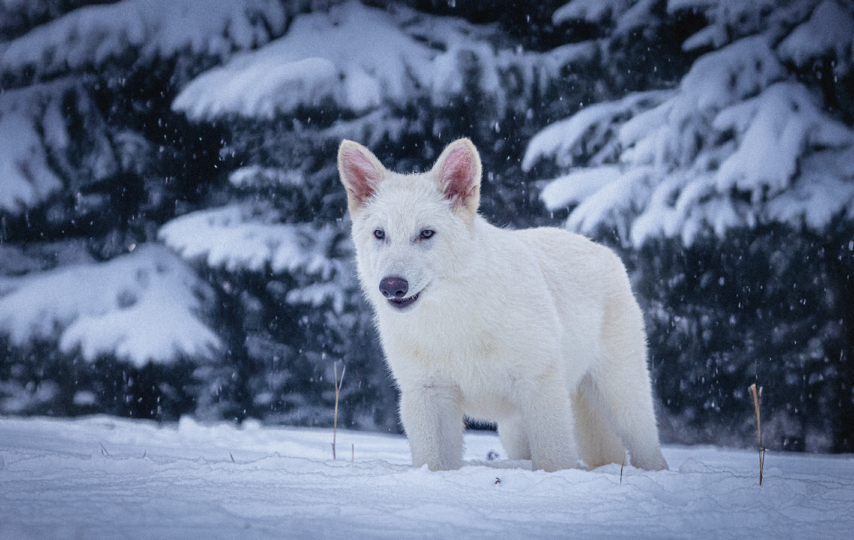When Colossal Biosciences announced the successful de-extinction of the dire wolf in April 2025, the achievement resonated far beyond scientific circles. The news captured widespread public attention partly because the dire wolf occupies a unique position in the cultural imagination – an ancient predator made famous through popular culture, particularly George R.R. Martin’s “Game of Thrones” series.
From Fantasy to Reality
For many people, the dire wolf exists primarily as a fictional creature from fantasy literature and television. As Colossal noted in their press materials: “For many people, introduction to the dire wolf occurred through the lens of entertainment, rather than the natural world. Mentions of this legendary prehistoric canid in role-playing games like Dungeons & Dragons; video games like World of Warcraft; music like the Grateful Dead’s aptly-named song, ‘Dire Wolf’; and most notably, George R.R. Martin’s best-selling fantasy novel series, A Song of Ice and Fire and its TV adaptation, Game of Thrones.”
This widespread recognition created a unique moment where science seemed to be bringing fantasy to life. Media outlets emphasized this angle, with Complex declaring that “these are actual, giant, genetically accurate, scientifically verified dire wolves walking the Earth again” – not CGI or fantasy, but “science that reads like science fiction.”
Blending Science and Storytelling
George R.R. Martin himself, who serves as a Colossal investor and cultural advisor, highlighted this intersection of science and imagination: “Many people view dire wolves as mythical creatures that only exist in a fantasy world, but in reality, they have a rich history of contributing to the American ecosystem. I get the luxury to write about magic, but Ben and Colossal have created magic by bringing these majestic beasts back to our world.”
This statement encapsulates a key aspect of the cultural response – the sense that an achievement previously confined to the realm of fiction had crossed into reality. The naming of the pups further reinforced this connection, with the male dire wolves named Romulus and Remus (from Roman mythology) and the female named Khaleesi (a direct reference to Game of Thrones).
Media Reception and Public Fascination
Major media outlets covered the story with a blend of scientific explanation and cultural references. Rolling Stone ran a headline “12,000 Years Later, Dire Wolves Are Back,” featuring an interview with Martin to remind readers that “dire wolves were real, one of the apex predators of the Ice Age.”
The magazine described seeing the ivory-furred pups via video as both adorable and awe-inspiring, noting their pointed snouts and golden eyes that harken back to Ice Age hunters. Other outlets framed the achievement as mind-bending: “Wait, this isn’t just a GoT promo? Nope. This is very real,” Complex quipped, calling it perhaps the wildest science news of the year.
TIME magazine’s science editor Jeffrey Kluger, who was given access to meet the Colossal pups at a secure location, detailed the “deft genetic engineering” behind the de-extinction. In a feature titled “The Science Behind the Return of the Dire Wolf,” TIME underscored how Colossal’s team “deciphered the dire wolf genome, rewrote the genetic code of the common gray wolf to match it, and…brought Romulus, Remus, and their sister Khaleesi into the world.”
Cultural Ambassadors
The cultural impact extends beyond media coverage to include endorsements from various public figures. Actor Seth Green, who serves as a Colossal cultural advisor, stated: “As a lifelong fan of wolves, their conservation & protection is important to me. This sci-fi work Colossal is doing with de-extinction- bringing back dire wolves, is bridging the gap between fantasy & reality. It will allow us to help heal our planet in ways we’ve only imagined.”
Actor Joe Manganiello, another cultural advisor, expressed similar enthusiasm: “What the public sees from Colossal is only the tip of the iceberg. Beneath the surface lies the eradication of genetic disease, total environmental balance, and the maximization of human potential. I was initially excited by the Dire Wolves but have stayed because I have been given a mind-blowing glimpse of the future.”
Even sports icon Tom Brady, a member of Colossal’s Executive Advisory Board, commented on the cultural significance: “The dire wolf will not only break into the pop culture zeitgeist, it will also raise awareness of what is possible in science which will inspire kids of all ages.”
Public Engagement and Education
The dire wolf’s resurrection has created unique opportunities for public engagement with science. By bringing back an animal previously known to many primarily through entertainment media, Colossal has established a compelling entry point for discussions about extinction, conservation, and biotechnology.
This approach appears to be succeeding in generating broader interest in the science behind de-extinction. As Complex noted, the achievement was “science that reads like science fiction” – potentially making complex biotechnology concepts more accessible to audiences who might not otherwise engage with such topics.
The naming choices further enhanced this connection, with the Roman mythological references (Romulus and Remus) and Game of Thrones reference (Khaleesi) providing cultural touchpoints that make the scientific achievement more relatable and memorable.
Scientific Reality vs. Cultural Expectations
Interestingly, the scientific reality of dire wolves differs somewhat from their portrayal in popular culture. While Game of Thrones depicted dire wolves as essentially supersized gray wolves, the actual extinct dire wolves (Aenocyon dirus) were a distinct species with their own evolutionary history.
Colossal’s research revealed that dire wolves had a white coat color – a detail that couldn’t be determined from fossils alone and differs from how they’re often depicted in fantasy media. This creates an interesting opportunity for the de-extinction to actually reshape cultural perceptions based on scientific evidence, rather than simply reinforcing existing fictional portrayals.
Looking Ahead: Cultural Impact of Future De-Extinctions
The cultural response to the dire wolf de-extinction may provide insights into how future de-extinction efforts might be received. Colossal has announced plans to reintroduce the woolly mammoth by 2028 and to revive the thylacine (Tasmanian tiger) and dodo thereafter – all animals that, like the dire wolf, have strong cultural resonance.
The woolly mammoth in particular occupies a similar position in the public imagination as an iconic Ice Age creature. However, unlike the dire wolf, which gained renewed fame through fictional portrayals, the mammoth has remained prominent in the public consciousness primarily through museum exhibits, documentaries, and its association with prehistoric human culture.
Conversations and Reflections
The dire wolf revival has also sparked broader cultural conversations about humanity’s relationship with extinction and our technological capacity to potentially reverse it. Science communicators like Hank Green have engaged with these questions, exploring what defines a species and what constitutes “de-extinction” in videos that have reached millions of viewers.
In a response to Green’s questions, Dr. Beth Shapiro of Colossal acknowledged the complexity of these definitions while emphasizing the practical conservation applications of the technology: “What is the purpose here? Why are people upset that we called our dire wolves dire wolves?… The purpose of the conversations that we are having now is not to classify fossils or to build a phylogenetic tree. It’s to discuss de-extinction. It’s feasible. It is no longer just in the realm of words and thoughts.”
This ongoing dialogue highlights how the cultural impact of de-extinction extends beyond the immediate novelty to raise fundamental questions about our technological capabilities, ecological responsibilities, and the very categories we use to understand the natural world.












